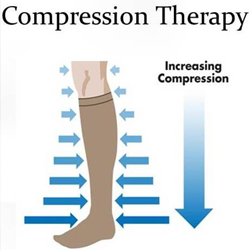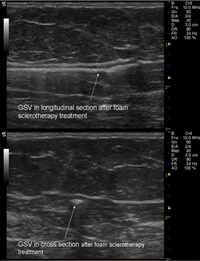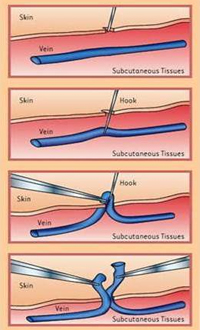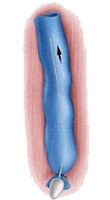Treatment Overview
GOAL – Superficial varicosities are the result of high-pressure flow into a normally low-pressure system. Varicosities carrying retrograde flow are hemodynamically harmful because they cause recirculation of oxygen-poor, lactate-laden venous blood back into an already congested extremity. The primary goal of treatment is the ablation of these reflux pathways with resulting improvement of venous circulation.
Treatment of Superficial Varicosities needs to be begun AFTER absolute certainty to rule out:
- Deep Vein Thrombosis
- Peripheral Arterial Disease
 A. Conservative Treatment:
A. Conservative Treatment:
Special support stockings are prescribed to slow down the progression of varicose veins. This is done for symptomatic relief, but they must be worn pretty much every day for the rest of your life to be effective. Stockings may help vein symptoms so long as they are worn, but they do not cure the problem. They are usually effective in small and medium sized varicose veins.
B. Medical Therapy: Though there are drugs available with possible increase in venous tone (strength of the wall), they are not much useful. Hence some form of Mechanical treatment is needed to block the abnormal venous circulation.
No oral or topical medications are of proven efficacy for venous disease. Several over-the-counter preparations make claims of efficacy, but prospective trials have not supported the use of any of these agents.
 C. Chemical Therapy/ Sclerotherapy: In this procedure, a sclerosing substance is injected into the abnormal vessels to produce endothelial destruction that is followed by formation of a fibrotic cord and eventually by reabsorption of all vascular tissue layers. For most veins, a detergent sclerosing agent is agitated with air to create a foam similar to shaving foam.
C. Chemical Therapy/ Sclerotherapy: In this procedure, a sclerosing substance is injected into the abnormal vessels to produce endothelial destruction that is followed by formation of a fibrotic cord and eventually by reabsorption of all vascular tissue layers. For most veins, a detergent sclerosing agent is agitated with air to create a foam similar to shaving foam.
Local treatment of the superficial manifestations of venous insufficiency is unsuccessful if the underlying high points of reflux have not been found and treated. Even when the patient appears to have only primary telangiectasia and the initial treatment seems to be successful, recurrences are observed very quickly if unrecognized reflux exists in larger subsurface vessels.
The safety of sclerosing agents in pregnancy has not been established.
D. Laser Therapy: (External)
Transcutaneous pulsed dye laser and intense-pulsed-light (IPL) therapy has proven effective for the tiniest surface vessels (eg, those found on the face), but this modality is not generally useful as primary therapy for treatment of spider veins of the lower extremity.
Because of the physics of light absorption, delivering an ablative dose of thermal energy to the vessel without damaging the overlying skin is difficult. Even an experienced practitioner may inadvertently cause painful skin burns that can lead to permanent hyperpigmentation or hypopigmentation. Most spider veins have associated feeding vessels that must be treated by some other means before the tiny surface vessels are amenable to laser or IPL treatment.
E. Surgical Therapy
- Ambulatory Phlebectomy:
The stab-avulsion technique (ambulatory phlebectomy) allows removal of short segments of varicose and reticular veins through tiny incisions, using special hooks developed for the purpose. This procedure is extremely useful for treatment of residual clusters after saphenectomy and for removal of nontruncal tributaries when the saphenous vein is competent.
- Open Surgery: Stripping and Ligation of incompetent Junction:
 There are no unique indications for open Surgery, now that better options by Minimally Invasive Surgery are available.
There are no unique indications for open Surgery, now that better options by Minimally Invasive Surgery are available.- Disadvantages include:
- Permanent Scars
- Needs longer hospital stay, more days off work and more pain, compared to Laser treatment,
- Wound infection, bleeding, inflammation, swelling and redness – risk of these are many fold more with open Surgery compared to a Laser Procedure.
- A very common complication is the damage of nerve fibres around the veins which can lead to pain.
- Radiofrequency Ablation: this is also a Type of Thermal ablation, but is not as popular as Laser Ablation
- Laser Ablation: Endo Venous Laser Therapy(EVLT) – more ahead

